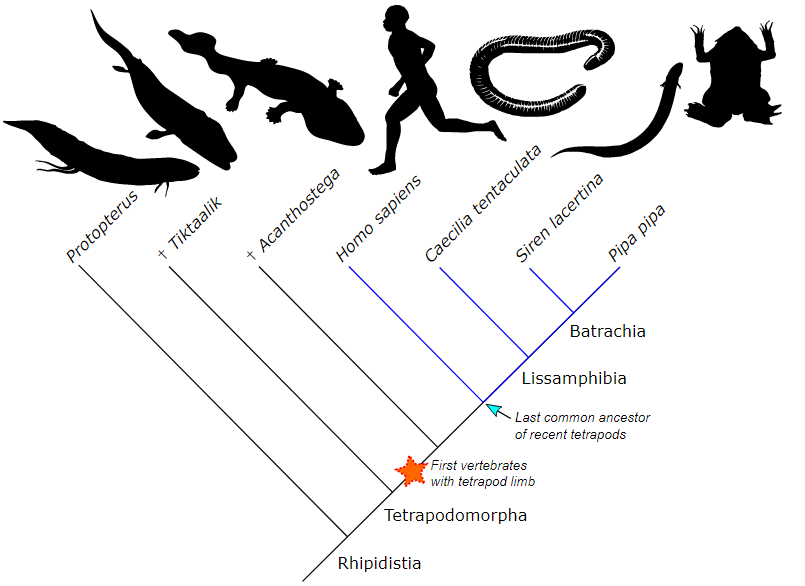The story of life on Earth is filled with remarkable evolutionary transitions, and one of the most fascinating is the rise of Tetrapoda. Tetrapods are vertebrates with four limbs (or derived structures), including amphibians, reptiles, birds, and mammals. They represent a monumental evolutionary leap—the movement from water to land.
Understanding Tetrapoda is crucial in biology because they illustrate how organisms adapt to changing environments, diversify, and shape ecosystems.
What is Tetrapoda?
Tetrapoda is a superclass of vertebrates within the phylum Chordata. The term comes from Greek:
-
Tetra = four
-
Pous (pod) = foot
Thus, Tetrapoda refers to four-limbed vertebrates and their descendants, even if some modern forms (like snakes or whales) have lost their limbs secondarily.
Tetrapods include:
-
Amphibians (frogs, salamanders, caecilians)
-
Reptiles (lizards, snakes, turtles, crocodiles)
-
Birds (avian reptiles)
-
Mammals (from tiny rodents to humans)
Evolutionary History of Tetrapoda
The evolutionary journey of tetrapods began about 360–370 million years ago during the Devonian period. Their ancestors were lobe-finned fishes, such as Tiktaalik, which possessed both aquatic and terrestrial adaptations.
Key Steps in Tetrapod Evolution
-
Lobe-finned fishes (Sarcopterygii) – Fins with bone structures resembling limbs.
-
Transitional forms – Tiktaalik roseae, with both gills and lungs, plus fin bones similar to wrists.
-
First Tetrapods – Amphibian-like animals such as Acanthostega and Ichthyostega that lived partly on land.
-
Amniotes – Evolution of the amniotic egg enabled reptiles, birds, and mammals to reproduce away from water.
This evolutionary transition is considered one of the most important moments in vertebrate history, allowing vertebrates to colonize diverse terrestrial habitats.
Characteristics of Tetrapoda
Tetrapods are defined by several shared traits:
-
Four Limbs – Usually with five digits, though modifications exist (e.g., wings in birds, flippers in whales).
-
Vertebral Column – A backbone that supports terrestrial movement.
-
Lungs – Adapted for breathing air.
-
Amniotic Egg (in amniotes) – Key innovation for reptiles, birds, and mammals.
-
Adapted Skeleton – Strong limb bones and pelvic girdles for weight support on land.
-
Diverse Skin Adaptations – From amphibians’ moist skin for gas exchange to reptiles’ scales and mammals’ fur.
Diversity of Tetrapoda
The superclass Tetrapoda encompasses millions of species across four major groups:
1. Amphibians
-
First tetrapods to evolve.
-
Life cycle includes both aquatic larvae and terrestrial adults.
-
Examples: frogs, toads, salamanders.
2. Reptiles
-
Evolved amniotic eggs, allowing full terrestrial living.
-
Includes turtles, lizards, snakes, crocodiles, and extinct dinosaurs.
3. Birds
-
Evolved from theropod dinosaurs.
-
Adapted for flight with feathers, hollow bones, and wings.
-
Represent a highly successful tetrapod lineage.
4. Mammals
-
Characterized by hair, mammary glands, and endothermy.
-
Range from whales in the ocean to humans.
Importance of Tetrapoda in Biology
Tetrapods are essential to both ecological balance and scientific study:
-
Ecological Roles
-
Amphibians as bioindicators of environmental health.
-
Birds as pollinators and seed dispersers.
-
Mammals as predators, prey, and ecosystem engineers.
-
-
Evolutionary Significance
-
Showcases adaptation from water to land.
-
Provides insights into evolutionary innovation.
-
-
Human Relevance
-
Humans themselves are tetrapods.
-
Tetrapods supply food, medicine, cultural value, and ecological services.
-
Challenges Facing Tetrapods
Despite their evolutionary success, modern tetrapods face threats:
-
Habitat Loss due to deforestation and urbanization.
-
Climate Change altering migration, breeding, and survival.
-
Pollution affecting amphibians and aquatic tetrapods severely.
-
Overexploitation from hunting, fishing, and the pet trade.
Conservation efforts are essential to protect tetrapod diversity.
Tetrapoda vs. Fish
| Feature | Tetrapoda (Amphibians, Reptiles, Birds, Mammals) | Fish (Ancestral Lineages) |
|---|---|---|
| Limbs | Four limbs (modified in some groups) | Fins |
| Breathing | Lungs (primary) | Gills (some with lungs) |
| Eggs | Amniotic (in reptiles, birds, mammals) | Aquatic, external fertilization |
| Habitat | Terrestrial & aquatic | Primarily aquatic |
| Skeleton | Weight-supporting girdles, strong bones | Adapted for buoyancy |
The Future of Tetrapod Studies
Modern biology continues to explore tetrapods through:
-
Paleontology – Studying fossils to trace their evolutionary history.
-
Genetics – Understanding gene adaptations for terrestrial life.
-
Conservation Biology – Protecting endangered tetrapod species.
Research on Tetrapoda not only helps explain the past of life on Earth but also informs future conservation and sustainability efforts.
Conclusion
Tetrapoda represents one of the most transformative evolutionary groups in history. From their origins in lobe-finned fishes to their dominance in terrestrial ecosystems today, tetrapods embody the story of adaptation, survival, and diversity.
Comprising amphibians, reptiles, birds, and mammals, they have not only shaped ecosystems but also influenced human culture, food systems, and scientific discovery. While challenges such as habitat loss and climate change threaten them, continued study and conservation will ensure that tetrapods remain an enduring part of Earth’s biodiversity.

